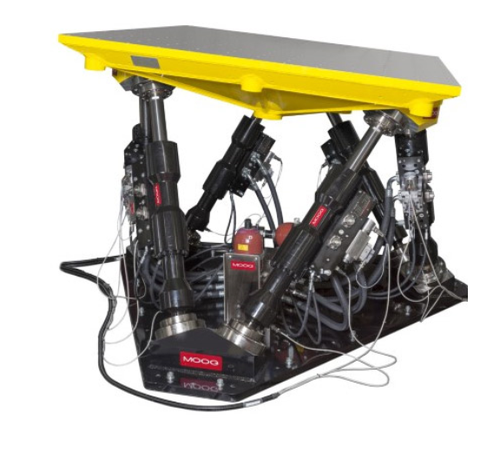Choosing the Right Simulation Table for the Design Job
Advances in simulation tables are allowing faster and more effective testing on new products, parts, and subsystems. What should a design engineer know to choose the right simulation table for the job?
June 15, 2015
Simulation tables have supported the job of fatigue testing car components for years, but other industries are enlisting these industrial workhorses to replicate everything from the sensation of driving a tank to the vibration a package "feels" as it snakes its way along the global supply chain. Even the things you don't typically think move, like a high-rise building, are getting a ride on simulation tables to assess the effectiveness of engineers' designs.
Advances in simulation tables (both electric and hydraulic) and the products underpinning them, such as fatigue-rated actuators, servovalves, and test controllers, are allowing faster and more effective testing on new products, parts, and subsystems.
What should a design engineer know to choose the right simulation table for the job?

Moog hydraulic simulation table ordered by Thule. (Source: Moog)
There are hydraulic and electric simulation tables. Both are also known as multi-axis shaker tables, or MAST, and are six-degree-of-freedom (DoF) systems. Both hydraulic and electric systems use integrated control hardware and application software to control position, velocity, and acceleration on the top platform.
MORE FROM DESIGN NEWS: The End of Throwing It Over the Wall
A hydraulic simulation table is comprised of a very stiff, aluminum-welded top platform and a steel baseplate. Mounted in between the top platform and baseplate are six, weight-optimized hydrostatic-bearing hydraulic actuators.
Hydraulic systems can typically handle higher payloads than their electric counterparts. In fact, a modern, high-performance hydraulic simulation table in hexapod configuration can be rated for payloads as high as 680 kg (1,500 lb), while providing frequency response up to 100 Hz and high acceleration levels of 10 G. Hydraulic systems are mainly used for fatigue testing.
In comparison, an electric simulation table uses electromechanical actuators and an electric cabinet containing the necessary electric drives. Engineers use these tables for functional testing at frequencies up to 30 Hz and accelerations to around 1 G. Electric tables are cleaner (i.e., no risk of hydraulic fluid leaking) and quieter than hydraulic systems. Electric systems are designed to perform, for example, functional tests and driver training by adding the vehicle motion.
As for power requirements, an electromechanical system typically uses only a quarter of the energy used by a hydraulic system, which requires a hydraulic pump unit. The latter produces a lot of heat and requires additional technology to cool the oil. No real difference exists in terms of space requirements, as electric simulation tables have approximately the same size footprint as hydraulic simulation tables.
Hydraulic simulation tables require a bit more maintenance than electromechanical tables because owners of the former must periodically change seals and hoses and clean the valves.
Companies choose high-performance simulation tables for a variety of reasons, including reducing time to market and testing the viability of a design. In the world of automobiles, designs have become highly complex. Now there are control units for the suspensions, exhaust line, and steering system, to name a few. Software linked to the simulation table systems replicates and plays out time history drive files that were recorded at the test track, or performs resonant-frequency research.
Twenty years ago it might have taken three to four years to develop a new car model. With realistic simulation, that timeframe is now between 18 and 24 months. This is not only because of better engineered simulation tables but also computer-aided engineering tools, which are far more accurate.
There remain possibilities to further improve simulation tables. In the past, design engineers created single-axis systems replicating, for example, heave. To bring more realism to testing, engineers can now opt for six-DoF systems, instead of simulating each axis (i.e., X, Y, and Z) separately.
The hexapod designs offer vector-based motion and can perform translation and rotation functions in conjunction with an expanded frequency range up to 100 Hz (for the hydraulic types). When automakers perform testing analysis, a lot of damage occurs within the range from 50 to 80 Hz. With older MAST, results are often filtered down to 40 Hz, so any damaging events beyond that point are not captured.
MORE FROM DESIGN NEWS: How Do You Make Quick-Turn Design & Production a Reality?
Initially, the auto industry relied on simulation tables for fatigue testing, but now carmakers also use simulation tables for functional testing. With an eight-DoF system, carmakers can achieve total pitch and roll angles of more than 50 degrees to simulate a continual acceleration of up to 12 m/s for the testing of fuel tanks.
A simulation table's usefulness isn't limited to the automobile industry anymore. Simulation tables can mimic everything from the motion of driving a tank and piloting a ship to testing a stabilization system and sloshing fluid in containers.
There are even larger simulation tables (with top platforms measuring 3 m by 4 m) that designers can use as the foundation for testing the effects of earthquakes on an office space. A company in Japan recently commissioned a simulation table to carry a full-scale office and subject it to a prolonged vibration of up to 20 Hz to evaluate different construction designs as they were struck with simulated tremors.
Even packaged goods firms are now showing interest in placing their palletized packaging on simulation tables to generate the movement and turning of a delivery truck. All of this is done to better understand whether manufacturing and shipping companies are adequately protecting their products during delivery. Anything of value that can be put in motion is a candidate for simulation testing.
Fons Hoeberichts is a business development manager for test systems at Moog. He can be reached at [email protected]
You May Also Like

.jpg?width=300&auto=webp&quality=80&disable=upscale)

